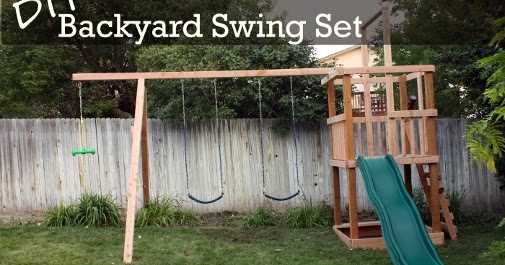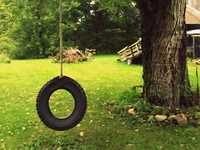Growing up, many of us have fond memories of playing on a swing in our backyard. It’s a simple pleasure that brings back a sense of carefree joy and adventure. If you’re feeling nostalgic and want to recreate those childhood memories for yourself or your own children, building a wooden swing can be a rewarding project.
A wooden swing provides a classic and natural aesthetic to any outdoor space. It blends seamlessly with the environment and adds a touch of charm and sophistication. Whether you have a large backyard or a small porch, a wooden swing can be a wonderful addition that will be enjoyed by both children and adults.
Building a wooden swing is also a great way to spend quality time with your loved ones. From choosing the right materials to measuring and cutting the wood, it’s a collaborative project that can be shared with family and friends. As you work together to build the swing, you’ll create lasting memories and strengthen your bond.
As you embark on this DIY project, keep in mind that safety is paramount. Make sure to choose a sturdy and durable wood such as cedar or redwood. These types of wood are known for their strength and resistance to decay. Additionally, be sure to meticulously follow the assembly instructions and double-check all connections to ensure the swing is safe to use.
Once the swing is complete, take a moment to admire your handiwork. Sit back, relax, and enjoy the simple pleasures of swinging through the air. Whether you’re swinging alone or with loved ones, this wooden swing will not only recreate childhood memories but also create new ones that will be cherished for years to come.
So, why not dust off your carpentry tools and embark on this nostalgic journey? Building a wooden swing will not only bring joy and relaxation to your outdoor space but also create lasting memories that will be treasured for a lifetime.
Choose the Right Location
When it comes to building a wooden swing, choosing the right location is crucial. Here are some factors to consider:
- Space: Ensure that you have enough space in your backyard or outdoor area to accommodate the swing comfortably. The swing set should have enough room for swinging back and forth without any hindrance.
- Safety: Look for a location that is away from any potential hazards, such as trees with low-hanging branches, fences, or other structures. It’s essential to provide enough clearance around the swing to prevent accidental injuries.
- Visibility: Consider placing the swing in a location that offers a good line of sight from your home or any other area where you might be supervising children. This way, you can easily keep an eye on kids while they’re enjoying the swing.
- Ground Conditions: Make sure the ground is level and stable for the swing. Avoid areas with uneven terrain or loose soil that could affect the stability of the swing set. If necessary, you may need to prepare the ground by leveling it or adding a layer of protective surfacing, such as rubber mulch or sand.
- Access to Shade: If you live in a hot climate, consider placing the swing in a location where there is natural shade provided by trees or other structures. This will make the swing more comfortable, especially during the summer months.
By taking these factors into account and choosing the right location for your wooden swing, you can ensure a safe and enjoyable experience for yourself and your family.
Gather the Necessary Tools and Materials
Before you can start building your wooden swing, you will need to gather all the necessary tools and materials. Having everything ready beforehand will ensure a smoother construction process and a quality end result.
Tools:
- Measuring tape
- Pencil
- Square
- Drill
- Table saw or circular saw
- Sandpaper or sander
- Paintbrush
- Safety goggles
Materials:
- Pressure-treated lumber (2x4s and 4x4s)
- Screws
- Eye bolts
- Chain or rope
- Swing seat or wooden plank
- Paint or sealant
- Hardware for hanging the swing
Make sure to choose high-quality materials that are durable and weather-resistant. Pressure-treated lumber is a good option for outdoor projects as it is designed to resist rot and decay.
Additionally, consider the weight capacity of the swing seat and choose appropriate hardware and chains or ropes that can support the weight of both children and adults.
Once you have gathered all the necessary tools and materials, you will be ready to move on to the next step of constructing your wooden swing.
Measure and Mark the Area
To begin building your wooden swing, you will need to measure and mark the area where it will be installed. This step is important to ensure that your swing is properly positioned and safe to use.
Here are the steps to measure and mark the area:
- Find a suitable location for your swing. Look for a spacious area with enough clearance around the swing to prevent any accidents.
- Using a tape measure, measure the length and width of the swing. This will help you determine the dimensions of the area needed for installation.
- Once you have the dimensions, mark the corners of the area using stakes or spray paint. This will serve as a guide for the next steps.
- Make sure to double-check the dimensions and adjust the markings if needed.
By measuring and marking the area beforehand, you will have a clear plan for the installation of your wooden swing. This will help ensure that everything is properly aligned and that the swing will be safe and enjoyable for everyone to use.
Digging Holes for the Posts
The first step in building a wooden swing is to dig holes for the posts. These holes will anchor the swingset and provide stability for the structure.
Here are the steps to dig the holes:
-
Measure and mark the locations: Use a tape measure and stakes to determine where the holes will be dug. Make sure to measure the distance between the posts accurately.
-
Gather the necessary tools: You will need a shovel, a post hole digger, and a level to dig the holes. Make sure the shovel and post hole digger are in good condition.
-
Start digging: Use the post hole digger to start digging the hole at the first marked location. Dig down to a depth that is deep enough to anchor the posts securely. Typically, a depth of at least 2 feet is recommended.
-
Check for levelness: Use the level to check if the hole is level. Adjust the hole as necessary to ensure that it is perfectly level.
-
Repeat for remaining holes: Repeat steps 3 and 4 for the remaining marked locations, ensuring that each hole is dug to the same depth and is level.
It is important to ensure that the holes are dug properly and are level to provide a stable foundation for the swing. Taking the time to measure, mark, and dig the holes accurately will help ensure the quality and longevity of the wooden swing.
Secure the Posts in the Ground
Securing the posts of your wooden swing in the ground is an important step in building a stable and safe structure. The posts will support the weight of the swing and ensure it remains sturdy during use.
To secure the posts, you will need the following materials:
- 4 wooden posts, each measuring at least 4 feet in length
- Shovel
- Quick-setting cement mix
- Water
Follow these steps to secure the posts:
- Determine the desired location of your swing and mark the spots where the posts will be placed. Make sure the area is clear of any utilities or obstructions.
- Using a shovel, dig holes that are approximately 2 feet deep and about 1 foot wide. The holes should be evenly spaced apart and aligned with the markings.
- Prepare the quick-setting cement mix according to the manufacturer’s instructions. This usually involves pouring the mix into a bucket and adding water. Stir the mixture until it reaches a thick consistency.
- Place one of the wooden posts into a hole, making sure it is centered and level. Have someone hold the post in place while you fill the hole with the cement mix. Use a level to ensure the post remains straight and upright.
- Repeat step 4 for the remaining posts, checking the alignment and levelness as you go.
- Allow the cement to set according to the manufacturer’s instructions. This usually takes a few hours.
After the cement has fully set, you can continue with the next steps of building your wooden swing. Securing the posts in the ground ensures that your swing will be stable and safe for you and your loved ones to enjoy for years to come.
Assemble the Frame
Before starting the assembly process, make sure you have all the necessary materials and tools ready. This will include the wooden boards, screws, a drill, a saw, a measuring tape, and a level.
Follow these steps to assemble the frame of the wooden swing:
- First, lay out the vertical side supports on a flat surface, making sure they are evenly spaced and parallel to each other.
- Measure and mark the desired height for the swing seat on each side support.
- Cut the horizontal top beam and the two seat support beams to the desired length.
- Place the horizontal top beam on top of the side supports, aligning it with the marked height.
- Attach the top beam to the side supports using screws, making sure it is securely fastened.
- Next, attach the two seat support beams to the side supports, positioning them below the top beam at the desired seat height.
- Securely fasten the seat support beams to the side supports with screws.
- Check that the frame is level using a level tool.
Once the frame is fully assembled, you can move on to attaching the swing ropes or chains and installing the swing seat. Refer to the next sections for detailed instructions on these steps.
Attach the Swing Seat
Once you have constructed the frame of the swing, it is time to attach the swing seat. Follow these steps to securely attach the seat:
- Measure and Mark: Begin by measuring and marking the center of the swing frame.
- Drill Holes: Use a drill to create two holes at the marked center of the swing frame. These holes should be large enough to fit the swing ropes or chains.
- Attach Swing Ropes or Chains: Thread the ropes or chains through the holes in the swing frame. Make sure they are even in length and securely tied or hooked to the frame.
- Secure the Swing Seat: Attach the swing seat to the ropes or chains, ensuring that it is centered and level. Use strong knots or carabiners to secure the seat in place.
- Test the Swing: Before allowing anyone to use the swing, thoroughly test its stability and ensure that all attachments are secure.
With the swing seat securely attached, your wooden swing is ready to provide hours of fun and nostalgic memories.
Test the Swing and Make Adjustments
Once you have finished building your wooden swing, it is important to test it to ensure it is safe and functional. Follow these steps to test the swing and make any necessary adjustments:
- Check the stability: Before testing the swing, ensure that it is securely fastened to a sturdy structure, such as a tree branch or a strong beam. Give the swing a gentle shake to make sure it is stable and does not wobble.
- Test the weight capacity: Place a weight on the swing that is equal to or slightly greater than the maximum weight it will be supporting. Gently swing back and forth to make sure the swing can handle the weight without any signs of strain or weakness.
- Inspect the ropes or chains: Carefully examine the ropes or chains that hold the swing. Look for any signs of fraying, stretching, or other damage. If you notice any issues, replace the ropes or chains before using the swing.
- Adjust the height: Test the swing at different heights to find the most comfortable and enjoyable height for swinging. Adjust the height as needed by either raising or lowering the attachment point of the ropes or chains.
- Check for smooth movement: Swing back and forth on the wooden swing to ensure that it moves smoothly and without any jerking or sticking. If there are any issues, carefully inspect the swing’s hardware and make any necessary adjustments.
- Make safety improvements: If you identify any potential safety hazards during the testing process, take the time to make the necessary improvements. This may include adding additional support or padding to certain areas of the swing.
By thoroughly testing and making any needed adjustments, you can ensure that your wooden swing is safe and enjoyable for both children and adults. Once you are satisfied with the swing’s performance, you can start creating new memories and reliving old ones on your newly built wooden swing.
FAQ:
Can I use any type of wood for building a swing?
While you can use various types of wood for building a swing, it is important to choose a durable and weather-resistant wood, such as cedar or redwood. These types of wood are more resistant to decay and can withstand outdoor conditions better than softer woods like pine.
Is it difficult to build a wooden swing?
Building a wooden swing can be a moderately challenging DIY project, especially if you have limited experience with woodworking. However, with the right tools and a clear set of instructions, it is achievable for most people. It might take some time and patience, but the outcome is rewarding.
Should I paint or varnish the wooden swing?
Painting or varnishing the wooden swing is optional but recommended. It can help protect the wood from weathering and extend its lifespan. Additionally, it allows you to customize the swing’s appearance and add a personal touch to your creation.
How long does it usually take to build a wooden swing?
The time it takes to build a wooden swing depends on your skill level, the complexity of the design, and the tools you have available. On average, it can take anywhere from a few hours to a couple of days to complete the project. It is important to plan ahead and allocate enough time to ensure a quality result.


